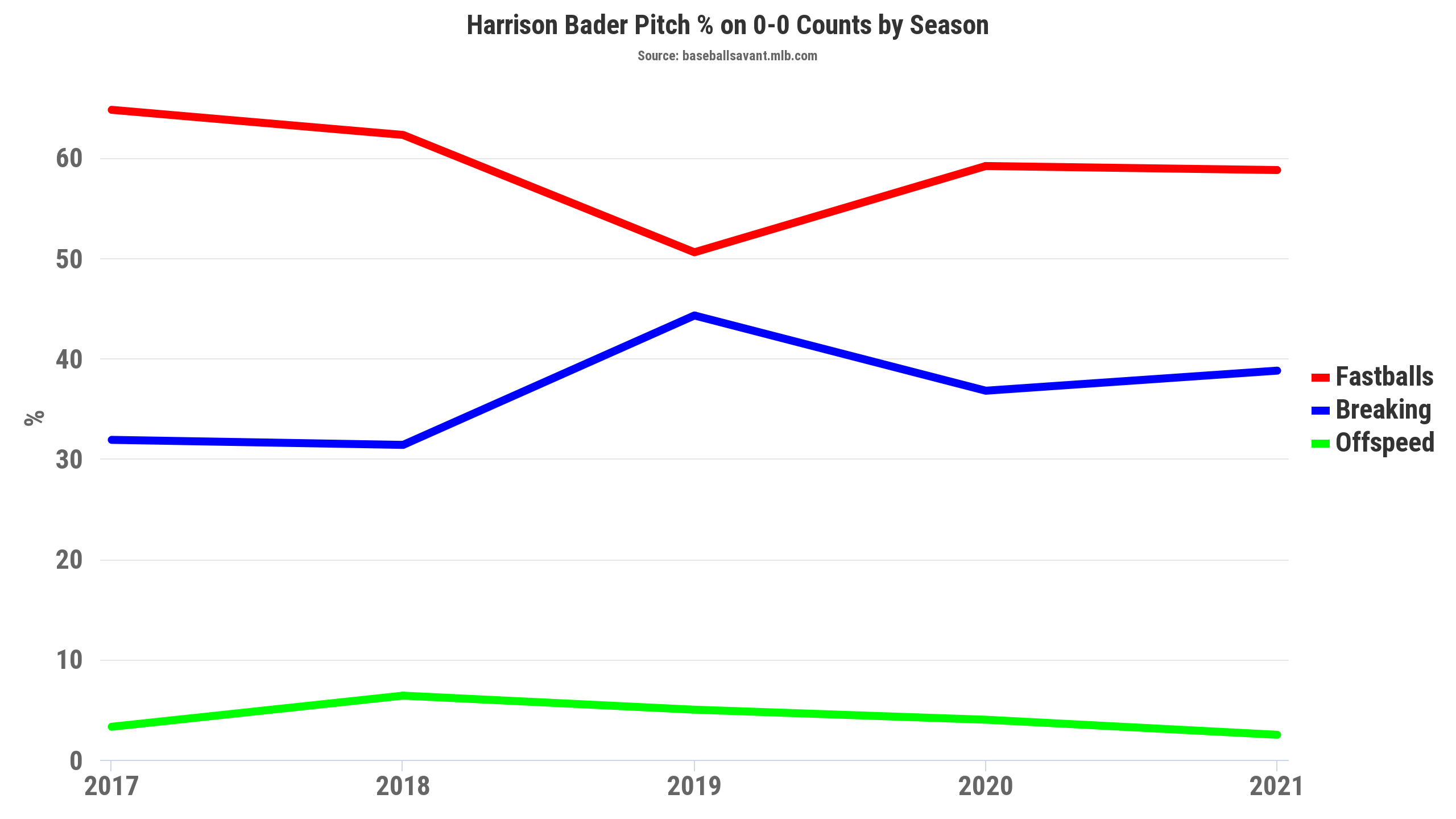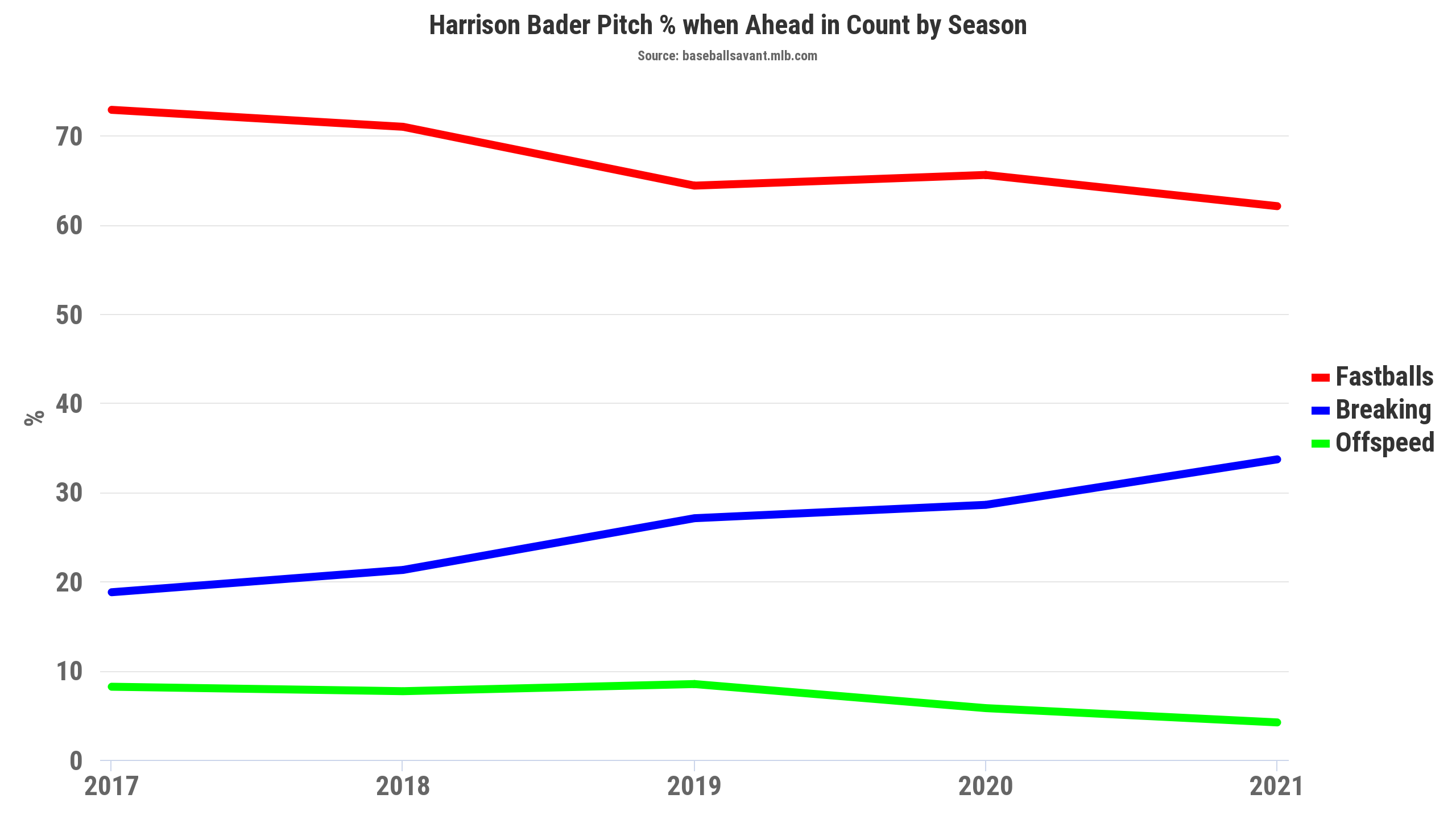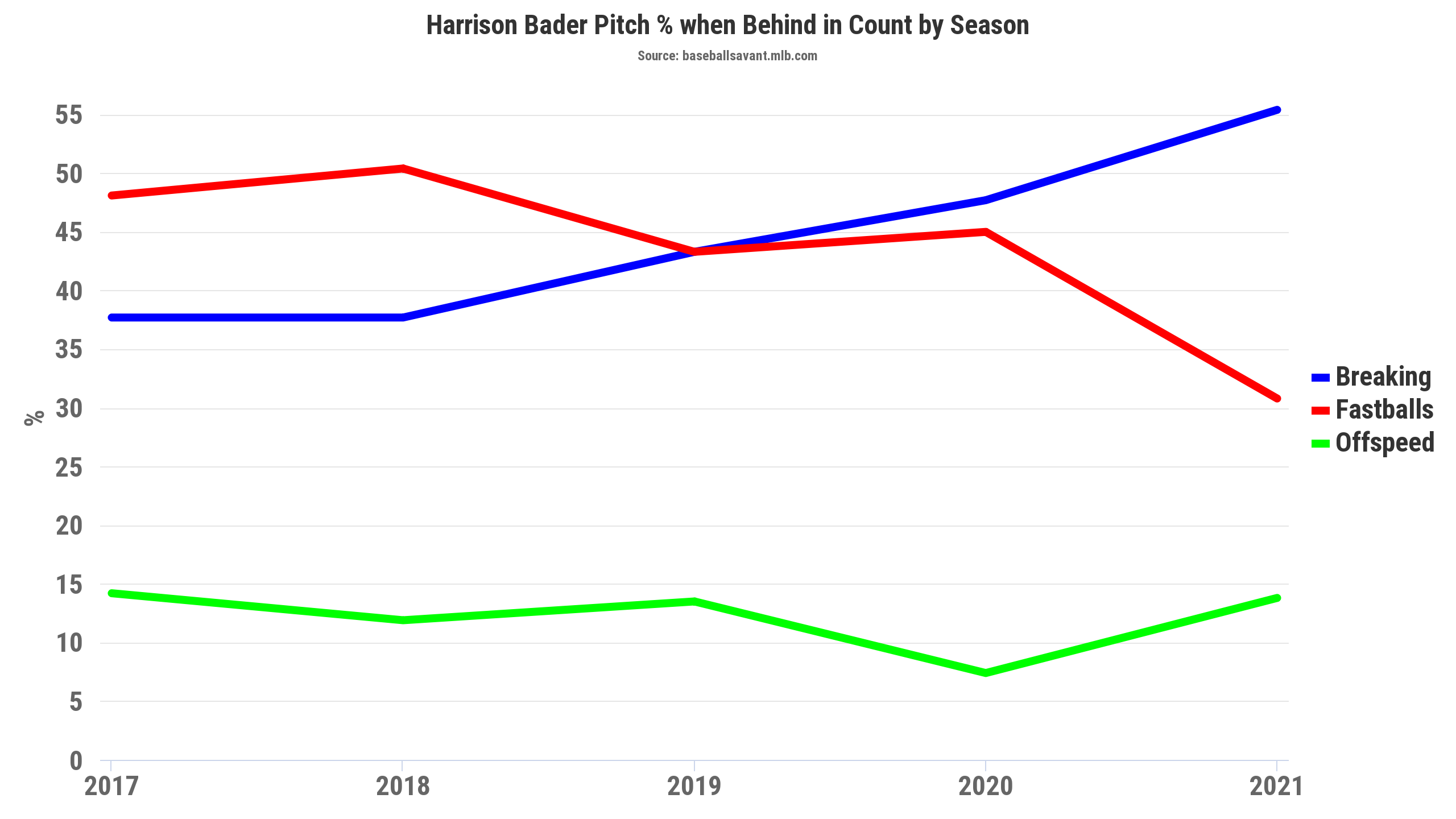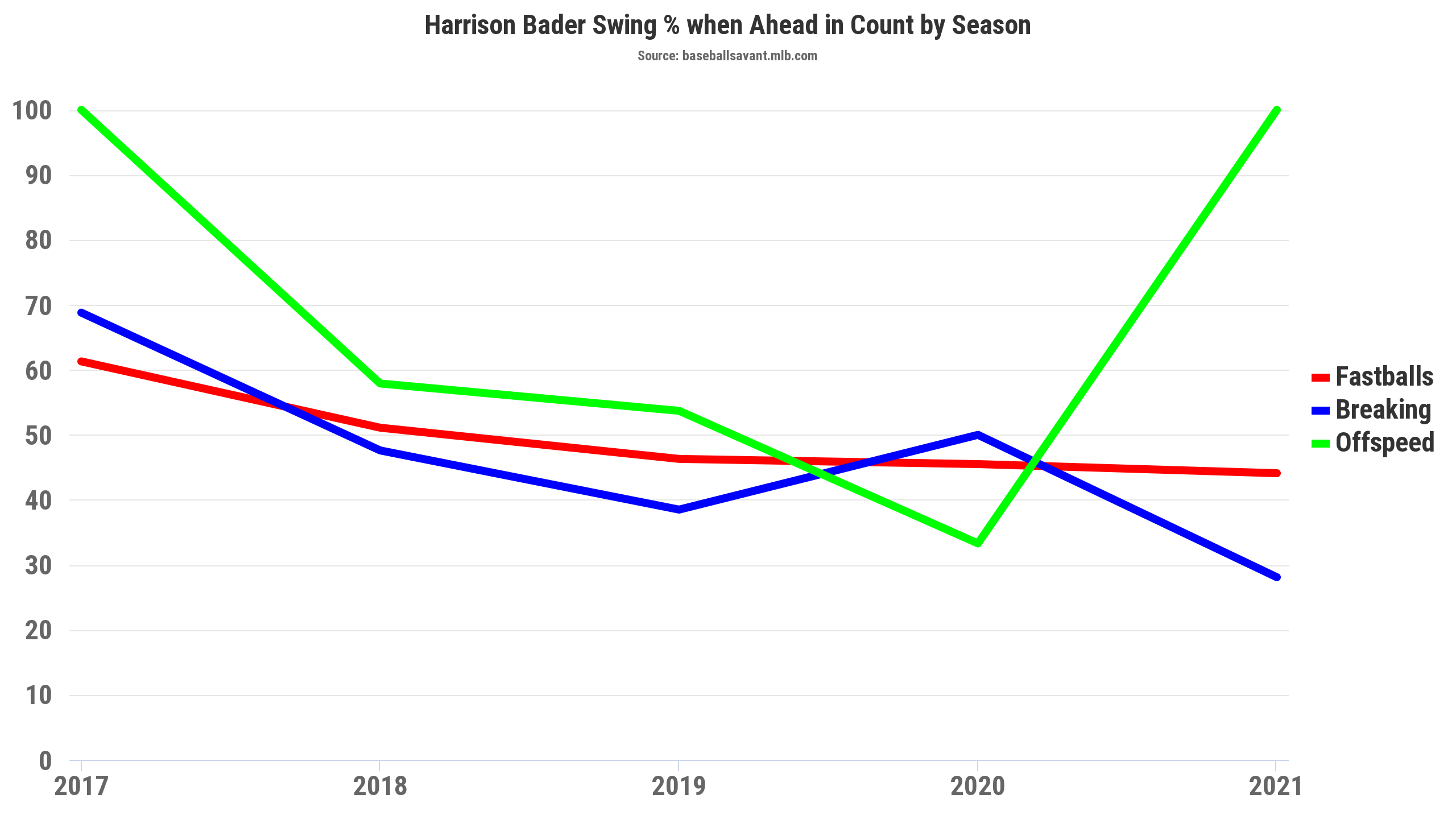Note: This post was written before Bader was placed on the injured list with a fractured rib.
When you think of the type of player that Harrison Bader is, you likely think about his outstanding defense and great speed before you think of his bat. And that’s for good reason, as his defense and speed have outpaced his bat thus far in his Major League career—he’s been one of the game’s best defenders and fastest runners since making his debut back in 2017. Those skills have been enough to keep him relevant and in the lineup most of the time for the Cardinals, but there has always been a question about what Bader may look like with a better bat.
While it’s hard to take away most things from the shortened 2020 season, it perhaps looked like Bader found something at the plate during it—at least in the power department. A high 32% strikeout rate kept his batting average low, but for the first time in his career, he had an isolated power mark greater than .200—generally the level where a hitter can be considered a “power hitter.” Now in 2021, while Bader missed most of April, Bader’s isolated power remains in that similar range at .192, but his biggest weakness—the elevated strikeout rate—has made an incredible turnaround, coming way down to just 13.5%. Setting the plate appearance minimums low enough to get to a point where Bader qualifies, he has been the largest of the strikeout rate improvers so far:
Of course, Bader is still sitting below 100 plate appearances, and this definitely qualifies as a small sample (get ready to see that disclaimer made a bunch in this post), but does that mean it should be written off completely? It doesn’t look that way, as Bader is legitimately doing some different things at the plate when it comes to his approach and discipline, which definitely appears to support his drastically lower strikeout rate in the early going this season.
While on the surface, it seems like Bader’s plate discipline has improved on account of the elevated walk rate (10.8%, right in line with last year), it needs to be kept in mind that Bader hits eighth in the Cardinals lineup most often, which means that a good amount of those walks have been of the intentional type, as a pitcher would much rather face an opposing pitcher, nothing new there. Elsewhere in his plate discipline profile, his overall swing rate isn’t much different from last season. It’s up just a couple of ticks from last season and isn’t anything out of the ordinary from elsewhere in his career. However, there are still some other things in Bader’s plate discipline profile that help explain his lower strikeout rate.
It seems that so far this year, Bader is being a lot more aggressive this season, with more swings at pitches in the zone and fewer chases.
Obviously, chasing less tends to lead to good things happening for a hitter’s strikeout rate. However, while this profile definitely does look different from last season, it’s still not all that different from where it’s been earlier in his career, as Bader had a similar zone swing rate in 2018, and likewise a similar chase rate in 2019, and I’m skeptical that a slight improvement in chase rate alone would improve a strikeout rate that much. Thankfully, there’s another factor going in Bader’s favor that seems to be helping him out: his rate of contact on the pitches he does chase. If the goal is not to strike out, it would be good to make more contact on the pitches one chases, which Bader is doing this season at a 64.3% clip compared to a 51% career average.
So, we see that, on the surface, there looks to be more raw aggression so far from Bader in the form of more zone swings, coupled with fewer chases, and with that, more contact on the pitches he does chase. But, it’s not just more raw swings that are helping Bader out this year; it’s him being more aggressive in the right places, which warrants a closer look.
First up, after being pretty passive on first-pitches in the last two seasons, it looks like Bader is swinging at more of them this season:
This big increase in first-pitch swing rate would imply that Bader is trying to jump at pitches earlier in counts and ultimately end up in fewer two-strike counts, which obviously leads to strikeouts. We can look at some early numbers to see how often Bader has been in each count this season as compared to last season:
Again, I need to reiterate that this is still a small sample we’re dealing with, so these rates will fluctuate as time goes on, but it does look like Bader is finding himself in fewer two-strike counts this year, and in general, just behind in the count less often. Let’s simplify the above table and break it out by count type:
So, it seems as the increase in first-pitch swing rate would suggest, Bader indeed looks to not only be jumping at pitches in earlier in counts but also finding himself behind in the count less often, which will help out a hitter’s strikeout rate.
But why all the hubbub over this? Why should we ultimately care about this shift from Bader? While this seems to be a good strategy to help a hitter lower his strikeout rate, I have a theory about why Bader might be jumping on these earlier-in-the-count pitches, and I think it goes beyond just wanting to get the strikeout rate down. I think it has to do with how Bader is being pitched to. Let me explain.
So far this season, Bader is seeing breaking balls at a slightly higher rate (39.9%), but it’s really not much higher than previously. But, it is important to keep in mind that breaking balls have given Bader quite a bit of trouble throughout his career:
Knowing that Bader has historically been weak against breaking balls throughout his career, it seems like a good idea for opposing pitchers to try and attack him with more of them. However, while Bader is still seeing a similar amount of breaking balls this season compared to other years, it doesn’t mean that those breaking pitches have been distributed evenly. First, let’s look at the rate of fastballs and breakers on the first pitch and when Bader is ahead in the count:


Bader clearly is getting more fastballs to start off at-bats, and he’s swinging more in those situations, as we saw by the jump in his first-pitch swing rate. It makes sense for pitchers to go with more fastballs when they’re behind in the count, so that should explain things in that situation. Now, look at how different things are when Bader is behind in the count:

Once Bader is behind in the count, pitchers really ramp up the breaking ball usage. It’s not a surprise for pitchers to do that, but considering Bader’s lackluster history against breakers, it makes even more sense to jack the breaker usage up in more favorable counts. Let’s try to sum this all up into one nice, handy table, and this time add in two-strike rates as well:
So, while Bader is getting more breaking balls this season regardless of each count scenario, he is still getting fewer of them when he’s in more favorable counts, as well as earlier in counts, which, as we know, is when he’s doing a lot more swinging.
This is significant because historically, Bader has been a much better fastball hitter. We know that he’s struggled with breaking pitches, but the difference is pretty dramatic when compared to how much better he’s handled fastballs:
Knowing that Bader tends to do a lot more damage on fastballs, it makes sense to try and jump on those fastballs in what look to be fastball counts—which for him usually come when he’s ahead in the count. Looking at his swing rate when he’s ahead in the count will show this, as his swing rate on fastballs in those situations is much higher than the breaking ball (we can pretty much ignore offspeed pitches here. Bader has gotten just four offspeed pitches when ahead in the count):

For whatever it’s worth, though, Bader is hitting much better against those pesky breaking balls this season. They’ve been a lot less trouble for him, with a .398 wOBA against, which is outpacing his results on fastballs by a wide margin. He still does whiff quite a bit against them, but pretty much every hitter whiffs a good amount against pitchers’ breaking stuff these days. So, while I’m here making this theory, it maybe doesn’t quite hold up in practice when looking at the numbers. But, coming into the season, with his past struggles against breaking balls well documented and easy to see, it seems like this shift in approach may have been a conscious decision by Bader and the Cardinals, and he may just be succeeding on breaking pitches in spite of this. Plus, again, the point of the small sample size needs to be brought up—his success against them may very well be noise at this point. There has been some suggestion that Bader has improved his pitch recognition in the offseason, but it ultimately remains to be seen if those breaking-ball adjustments will stick. He may well be a better breaking-ball hitter, but likely not this good.
Overall though, this does seem like a good strategy for Bader to try and follow: hunt fastballs early and in favorable counts and to try and avoid two-strike counts, which is when the breakers really start to come in at an elevated rate. Teams aren’t stupid, though, and they’ll likely try adjusting how they’re pitching to him and try getting him out in other ways. They could try reversing course and pepper him with even more breaking balls. He is notably seeing even fewer offspeed pitches than he once did, so maybe something could be done there as well. It’s probably not that simple from an opponent’s point of view, but there could be some differences in how he’s pitched in the future, which would at least us see if Bader’s actually a better hitter against breaking balls or not, but that still has yet to come as of now. All of that should be kept in mind, though, when evaluating what Bader is going forward.
Things will continue to ebb and flow for Bader throughout the season; that’s just the nature of the game. It’s possible that these early changes he looks to have made won’t stick, and even then, Bader isn’t likely to turn into an elite hitter at the plate, as he is still not performing as well against right-handed pitchers, for instance, which would be a concern for the future. He’s also had some early BABIP issues that haven’t fully corrected just yet. Still, with the differences in his swing profile that has him being more aggressive early in counts and hunting out fastballs when he gets them, things could look a lot different for Bader once things start to come around, and that is definitely exciting.
Photo by Andy Lewis/Icon Sportswire | Adapted by Aaron Polcare


Everytime you guys write multiple stories about the same exact thing, the guy gets hurt. So maybe don’t?